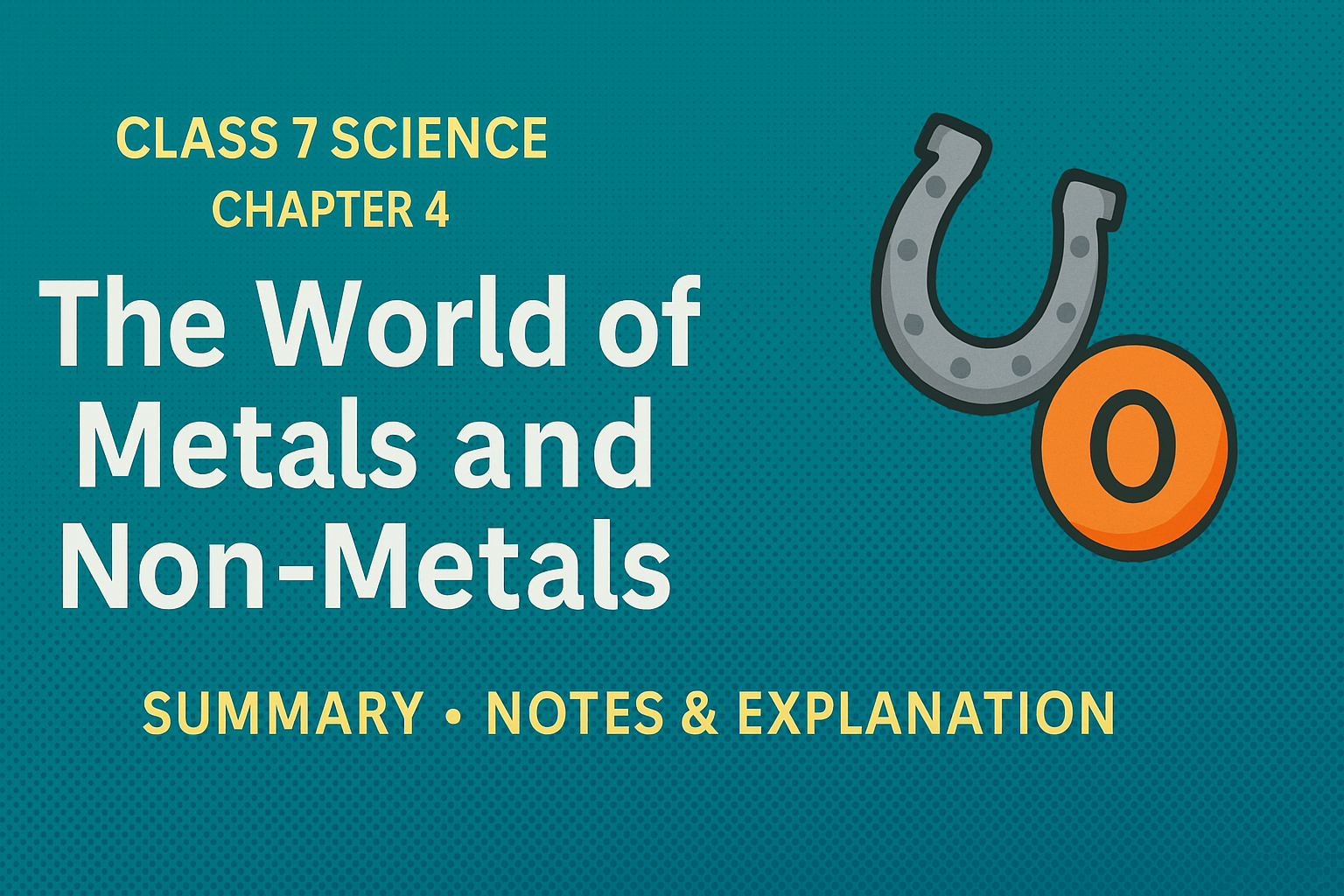Chapter 4 – The World of Metals and Non-Metals | Class 7 Science Chapter Summary, Notes, Explanation & NCERT Solution
Chapter Name: The World of Metals and Non-Metals
Subject: Science – Grade 7
🌟 Introduction – Chapter Summary of Chapter 4
We use metals and non-metals every day — from iron tools to oxygen for breathing. This chapter helps students understand the basic properties, uses, and differences between metals and non-metals, and how they behave in the presence of air, water, and heat. It also explains the importance of both in our daily lives, including their chemical and physical properties.
🧲 What Are Metals?
Metals are elements that are usually hard, shiny, malleable, ductile, and good conductors of heat and electricity. They are used in making utensils, wires, machines, and tools.
✅ Common Properties of Metals:
- Lustrous (shiny) – Example: Copper, Aluminium
- Malleable – Can be beaten into thin sheets (like silver foil)
- Ductile – Can be drawn into wires (like copper wires)
- Sonorous – Produce ringing sound when struck
- Good conductors – Carry heat and electricity (used in cookware and wires)
- Generally solid and hard – Except mercury (which is a liquid at room temperature)
🧪 What Are Non-Metals?
Non-metals are elements that are usually soft, dull, brittle, and poor conductors of heat and electricity. They are very important for life processes and the environment.
✅ Common Properties of Non-Metals:
- Non-lustrous – Dull in appearance (like coal or sulfur)
- Not malleable or ductile – They break when hammered
- Poor conductors – Except graphite
- Can be gases, liquids, or solids – Example: Oxygen (gas), Bromine (liquid)
- Essential to life – Like oxygen for breathing, nitrogen for plant growth
🛠️ Activities that Show Metal Properties
🔨 Malleability:
When you beat copper, aluminium, or iron with a hammer, they flatten. This is malleability – a key property of metals.
🔌 Ductility:
Copper and aluminium can be made into thin wires used in electric cables. That’s called ductility.
🔔 Sonority:
Metals make a ringing sound when dropped. Try it with a metal spoon versus a wooden one – only the metal will sound clear and loud.
🔥 Conductivity:
When you place metal and wooden spoons in hot water, the metal heats up faster. Why? Because it conducts heat better.
⚡ Electrical Conductivity:
In a simple circuit, only metal objects make the bulb glow, showing they conduct electricity.
🧪 Reaction of Metals with Air and Water
🌬️ Rusting:
Iron reacts with air and moisture to form rust – a brown flaky substance. This is a chemical change and damages iron objects.
Rusting = Iron + Water + Oxygen → Iron Oxide (Rust)
Prevention:
- Painting
- Oiling
- Galvanisation (coating with zinc)
🔥 Magnesium Reaction:
Magnesium ribbon burns with a bright white flame, forming magnesium oxide, which turns red litmus blue — showing it’s basic in nature.
💧 Sodium Reaction:
Sodium is a very reactive metal. It catches fire when it touches water or air, so it’s stored in kerosene.
🔬 Non-Metal Reactions
🌫️ Sulfur Burning:
Burning sulfur produces sulfur dioxide gas. When it dissolves in water, it forms an acidic solution that turns blue litmus red. Non-metal oxides are usually acidic.
❌ Water Reaction:
Most non-metals like sulfur and phosphorus do not react with water the way metals do. Phosphorus is stored in water to stop it from catching fire in air.
♻️ Are Non-Metals Important?
Absolutely! Non-metals are essential for life.
✅ Everyday Uses:
- Oxygen – Vital for respiration
- Carbon – Main element in all living things
- Nitrogen – Used in fertilizers to help plants grow
- Chlorine – Used to purify water
- Iodine – Used as antiseptic on wounds
Non-metals may not be shiny or hard, but they are just as important as metals!
🧠 Metal vs Non-Metal – At a Glance
| Property | Metals | Non-Metals |
|---|---|---|
| Appearance | Lustrous (shiny) | Non-lustrous (dull) |
| Malleability | Malleable | Not malleable |
| Ductility | Ductile | Not ductile |
| Sonority | Sonorous (ringing sound) | Not sonorous |
| Heat Conductivity | Good conductor | Poor conductor |
| Electrical Conductivity | Good conductor | Poor conductor |
| Oxide Nature | Basic | Acidic |
| Reaction with Water | Some react (e.g., Sodium) | Usually no reaction |
🏛️ Ancient India and Iron
India’s skill in metallurgy was world-class even thousands of years ago. The Iron Pillar of Delhi, built during Chandragupta II’s time, hasn’t rusted in over 1600 years, showing the advanced metal knowledge of ancient India.
🧠 In a Nutshell – Chapter Recap
- Metals are hard, shiny, malleable, ductile, and conduct heat and electricity.
- Non-metals are dull, brittle, and are poor conductors.
- Metals form basic oxides; non-metals form acidic oxides.
- Rusting is a chemical change caused by moisture and air.
- Combustion, burning, and corrosion are examples of metal reactions.
- Non-metals are essential for life, health, agriculture, and environment.
*~*Summary Ends here*~*
Watch the Video Explanation Here:⏬
Watch the NCERT Solution Here:⏬
Download free PDF here: ⏬
⚠️Beware of Cyber-Crime and Cyber-Fraudulent⚠️

